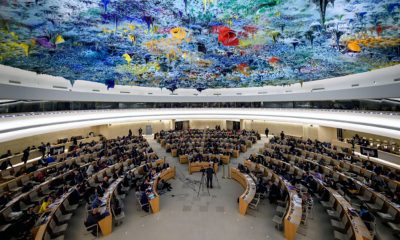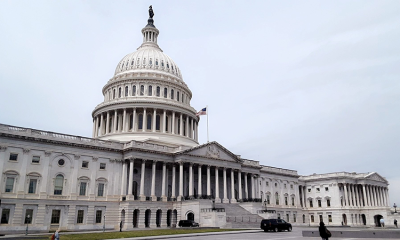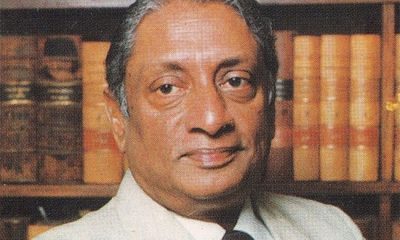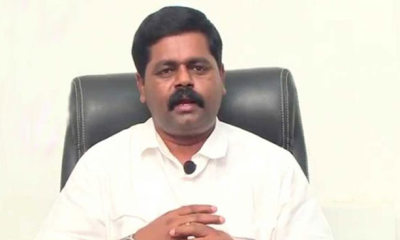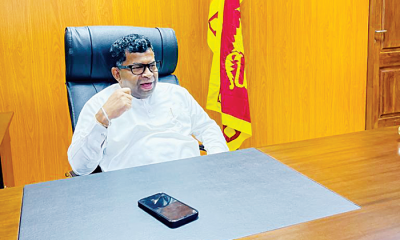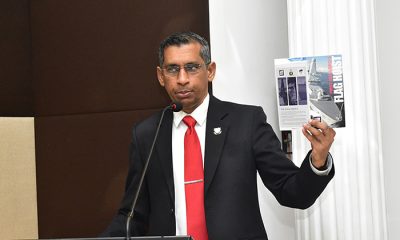Features
REFLECTIONS ON THE LIFE AND TIMES OF LAKSHMAN KADIRGAMAR
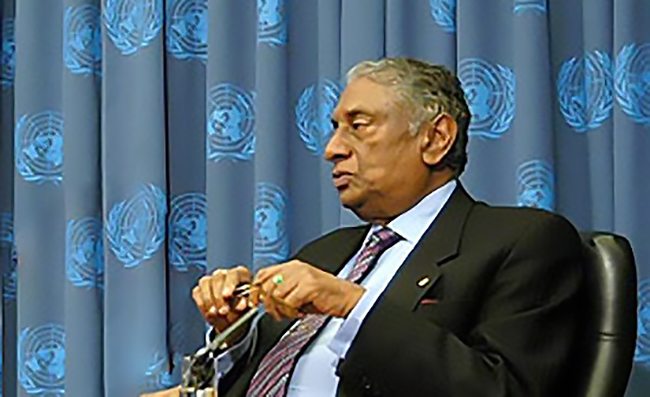
by Tissa Jayatillake
From the time I was old enough to cultivate an interest in politics, I have familiarized myself with the life and times of those political personalities I took a liking to. The late Dudley Senanayake (who incidentally died in 1973 a day after Lakshman Kadirgamar’s 41st birthday) was the first I took to and I consider it my loss that I did not have the opportunity to get to know him personally.
Of the several politicians that I have subsequently taken note of, there were two I got particularly close to and they were both, coincidentally enough, Oxonians who happened also to be presidents of the Oxford Union in their time. I refer to Lalith Athulathmudali and Lakshman Kadirgarmar. Athulathmudali did not attend a local university prior to going up to Oxford, as did Kadirgamar. The former’s cake, (to borrow a metaphor from Kadirgamar himself) was not baked at home, unlike that of the latter for whom Oxford was only the icing on his superlative, home-produced, academic confection.
Although Lakshman Kadirgamar and I belonged to two different generations, we shared certain commonalities. Though not of Kandy, we both had our early education in that city (he at Trinity, I at Kingswood) and we were both products of the University of Ceylon, Peradeniya. If memory serves, he was a resident of Arunachalam Hall, which was also where I spent my undergraduate years. He was a ‘citizen of the world’, a Sri Lankan and a Tamil. Likewise I, too, prefer to transcend narrow boundaries and take pride in being in that order, a human resident of this planet, a Sri Lankan, and then a Sinhalese.
I liked Kadirgamar’s academic bent of mind. If he and I were given to clichés, I would have called him ‘a voracious reader’. I should, instead, describe him as a man of books. And many were the times when we compared notes on literary texts we both had read and enjoyed. Not infrequently he telephoned me to double check on a quotation from a Shakespearean play that he wished to include in a lecture or a speech he was writing up. He publicly denounced bribery and corruption in public office, a particular aversion of mine, which is not a safe or fashionable public stance for a politician to take and I admired him for his courageous stand.
Furthermore he was unpretentious, charming, mellow-toned and possessed of a fine if often ironic sense of humour. And there was something else he was proud to be– an outstanding sportsman. The last attribute meant, by definition, that he was by instinct and training, fair-minded. Could one possibly ask for more? My one regret is that I did not get to know Lakshman Kadirgamar as intimately earlier than I actually did. I console myself with the thought that quality ever trumps quantity when it comes to most good things of life. As Ranil Wickremesinghe noted in the course of his tribute to Lakshman Kadirgamar in Parliament, a meal with the late minister offered food for the body as well as the mind. On most occasions a mere chat over a drink with him provided such nourishment for the soul.
Apart from our regular meetings to talk of issues of the day, there were two key projects dear to his heart that brought us together and helped cement our friendship. Given the rich heritage we Sri Lankans are heirs to, Lakshman Kadirgamar was of the view that we should give to the world, as he so aptly put it, ‘something more than just tea, tourism and terrorism’. He thus had a long-term plan to enable Sri Lanka to continue to contribute to the world of culture and the arts as also to the further refinement of international relations and diplomacy. It was his desire to have a book published on a Sri Lankan artist that would be ‘an ideal brand label for Sri Lanka, an image which may be projected all over the world as the face of Sri Lanka in all of its many forms’.
The result of his endeavours in this regard is the monumental and exquisite The World of Stanley Kirinde (2005) authored by Sinharajah Tammita-Delgoda. Having initiated the book project, he next set his sights on the production of an academic journal for the study of politics and diplomacy via the Bandaranaike Centre for International Studies (BCIS) of which he was now chairman. He invited me to serve as editor and together we put in many hours to get International Relations in a Globalizing World (IRGW) off the ground. Lakshman Kadirgamar’s last public act on the evening of that fateful twelfth of August, 2005, was to preside over the ceremony to mark the release of the inaugural issue of IRGW. It was Kadirgamar’s expectation, through the regular publication of IRGW, to raise the level of Sri Lanka’s contribution to diplomacy. All these best-laid plans and goals were shattered on that dreadful August night in 2005. Unfortunately Lakshman Kadirgamar did not live to see (though he saw the finished product and admiringly flipped through its pages) the release of The World of Stanley Kirinde scheduled for 18 August, 2005.
In this tenth year after his death, it is as good a time as any, to assess dispassionately the late foreign minister’s contribution to Sri Lanka and the world, and to imagine the kind of role he might have played had he lived beyond his 73rd year. I consider Lakshman Kadirgamar to be one of the finest twentieth century Sri Lankans and far and away the best foreign minister Sri Lanka has had to- date. He was widely read and intelligent and, at the same time, hard-working and disciplined. He had the courage of his convictions and the inner strength to hold fast to his ideals from his entry into the fickle world of politics in 1994 until his tragic end in 2005.
I tend to view Lakshman Kadirgamar’s performance on the domestic political front less enthusiastically than that of his on the international stage. It is entirely possible that my lukewarm view has less to do with any inadequacy of Kadirgamar’s and more to do with my aversion to realpolitik, especially to its Sri Lankan variety. As I have asserted in an earlier tribute to him (2005), Lakshman Kadirgamar was the quintessential Sri Lankan. Almost a year before his death, in September 2004, he made a profound statement on Japanese National Television (NHK) that encapsulated his credo:
I am first and foremost a citizen of Sri Lanka. I do not carry labels of race or religion or any other label. I would say quite simply that I have grown up with the philosophy that I am a citizen of the world. I do not subscribe to any particular philosophy; I have no fanaticism; I have no communalism. I believe there should be a united Sri Lanka. I believe that all our peoples can live together, they did live together. I think they must in the future learn to live together after this trauma is over. We have four major religions in the country: Buddhism, Islam, Hinduism and Christianity. All these religions exist very peacefully. They get on very well. I see no reason why the major races in the country, the Tamils and the Sinhalese, cannot again build a relationship of confidence and trust. That is my belief.
It is this fervent belief in the essential goodness of his country and fellow citizens that form the cornerstone of his diplomatic labours. It was also the driving force behind his brilliant and spellbinding performance as our foreign minister. I relished in particular the manner in which he finessed the challenge of LTTE terrorism. To say it was primarily Lakshman Kadirgamar’s powers of persuasion and skillful handling of domestic issues and their international ramifications that redeemed Sri Lanka’s sullied image is surely no exaggeration. Dedicated, experienced and effective Sri Lankan Foreign Service personnel played their part in this restoration process, but the helmsman was clearly Lakshman Kadirgamar.
In their measured tributes to a book published in honour of Lakshman Kadirgamar (Roberts: 2012), three seasoned American diplomats I know intimately, Karl (Rick) Inderfurth, Peter Burleigh and Shaun Donnelly who interacted closely with Kadirgamar have testified to the latter’s major successes on the international stage, during his lifetime and even posthumously. Chris Patten, the British politician, reinforces this fact when he notes in the same publication that:
Lakshman Kadirgamar spent much of his diplomatic energy and his formidable eloquence in attempting to persuade foreign governments to proscribe the LTTE in their own countries and stop the raising of funds for terrorism in Sri Lanka. He scorned the ‘Nelsonian’ attitude to terrorism of some countries. He was particularly active in supporting the drafting of the 1997 UN Convention for the Suppression of Terrorist Bombings. The respect he enjoyed internationally meant that his assassination nudged some foreign governments into taking a tougher line in prohibiting active support for the LTTE in their own countries.
Peter Burleigh in a recent personal communication reiterated this foremost aspect of Kadirgamar’s achievement when he noted:
I personally believe that his efforts to get important governments like Australia, the UK and the US to ban money transfers to the LTTE was a key contribution to the long-term effort to defeat the group. And his personal efforts, and effectiveness, in that regard were essential to that success.
Although I recognize that politics may well be the art of the possible, my limited experience of it as a practitioner and deeper awareness of it as student, make me conclude that politics is a murky and dismal business. I have often wondered why men of the sensitivity of Neelan Thiruchelvam and Lakshman Kadirgamar ever took to politics. In a statement over national television in 1994, Lakshman Kadirgamar spelt out his reasons for doing so. I quote below the operative paragraph of that statement:
I have had a privileged life by birth, by education, by access to opportunities, and I have always felt that a time must come when you must give something back to the society in which you have grown up and from which you have taken so much. So-called educated people must not shirk responsibilities in public life. I have reached that stage in life when, without being heroic about it, I feel I should participate more fully in public life.
Whilst not taking anything away from his invaluable and splendid contribution as foreign minister, I remain convinced that he could have given more back to the society from which, by his own admission, he had taken so much by opting for a different if less glamorous public role than that of a high visibility politician. As with similarly gifted men as S.W.R.D Bandaranaike, N.M Perera, Pieter Keuneman, Felix Dias Bandaranaike and Lalith Athulathmudali before him, I am left with the nagging feeling that his stint in politics somehow diminished Lakshman Kadirgamar in the end. Such diminution as occurred may well have been due to the corrosive nature of politics and not due to any inherent flaw in Kadirgamar’s character.
Perhaps he permitted his colleagues and his party to exploit his standing in society and his professional stature when he decided ‘without being heroic about it. . . [to] participate fully in public life’. Be this as it may, I remain disappointed by the narrow political role he played in the difficult and often acrimonious days of Sri Lanka’s French-style co-habitation government. This was the period between December 2001 and April 2004, when Kadirgamar’s party leader, Chandrika Kumaratunga, despite her party being out of power, was yet the constitutional head of government whilst Ranil Wickremesinghe as prime minister was in effective control of Parliament. Kadirgamar now was assigned the role of advisor to the president on international affairs, with Tyronne Fernando occupying the portfolio of foreign affairs.
On becoming prime minister in February 2002, Ranil Wickremesinghe entered into a Ceasefire Agreement (CFA) with the Liberation Tigers of Tamil Eelam (LTTE). The CFA was brokered by the Norwegians, who were at the time involved in Sri Lanka’s peace process, and Wickremesinghe presented his cabinet and his president with a fait accompli. Although initially Kadirgamar’s statement in Parliament in 2002 in response to that of the prime minister reflected a refreshing degree of constructive cooperation, a little over a year later in a speech in Parliament on 8 May, 2003, doubtless on the authority of President Kumaratunga and the Parliamentary Group of the People’s Alliance, Kadirgamar attacked the CFA arguing that it was ‘a structurally flawed document’. Clearly Kadirgamar was here being sucked into petty politics as borne out by a subsequent observation of General Satish Nambiar, the well-known Indian strategic expert engaged by the government of Sri Lanka at that time. In a communication in January 2010 dealing with that fraught situation of 2003, Nambiar refers to a one-on-one lengthy meeting he had with Kadirgamar during his last visit to Sri Lanka in 2003. In the course of that meeting Nambiar had told Kadirgamar that he was hurt by the suggestions made by some of Kadirgamar’s party members that he [Nambiar] was manipulating his report. Nambiar comments:
[Kadirgamar’s]disarming response was typical of him: that I should allow for the politics of the situation where the parties will use any means to put the ruling dispensation on the defensive. [Roberts: p. 204]
When one reads Kadirgamar’s 8 May, 2003 speech in hindsight, one clearly recognizes that his arguments against the CFA are not without merit. But the key point that needs emphasis here is that by being a willing party to political manipulation of something as highly sensitive as the CFA, Kadirgamar had begun to slip somewhat from the lofty pedestal of statesmanship he had been on hitherto. In the process, Kadirgamar and his political companions failed to give any credit whatsoever or even the benefit of the doubt to Wickremesinghe.
We now know though that through the CFA the LTTE were led into a corner and to peace negotiations, with some even referring to it as ‘a peace trap’. Wickremesinghe’s CFA, for all of its ‘structural flaws’, was as much a ploy as was the Kumaratunga government’s 1998 decision to use the Norwegians as ‘facilitators’ in the unofficial conversations between the then government and the LTTE. And, yet, Kumaratunga and her paarty were now opposing, seemingly for the sake of opposition, the Norwegians (their ‘facilitators’) and Wickremesinghe, for the signing of the CFA with Kadirgamar lending his forensic debating skills for the cause in Parliament. A similar but less nationally harmful political misjudgement was Kadirgamar’s decision, despite sincere and pragmatic advice against the move from close associates, to contest the incumbent Secretary- General of the Commonwealth in 2003. He was roundly defeated by 40 to 11.
On balance, Kadirgamar’s overall achievement as politician and foreign minister, despite blemishes referred to above, is marvellous. Unlike the average gifted person who tends to rest on his laurels, Kadirgamar was exceedingly hard-working from beginning to end. Like a good lawyer, he always studied his brief well and, like a good sportsman, he was ever thorough in his preparation. It is this careful preparation in combination with his ability and flair that made Kadirgamar who he was. He was consistent and relentless in his opposition to political violence which he saw as a threat ‘to the stability within and between states throughout the world’.
Well before the cataclysmic ‘9/11’, he warned western governments of the dangers of terrorism and called for joint action to deal with the scourge. Among his several notable speeches on the problems of terrorism, perhaps the most influential was that he made at Chatham House, London, on 15 April, 1998 at a meeting held under the auspices of the Royal Institute of International Affairs and the International Foundation of Sri Lankans. ‘[A] terrorist act’,Kadirgamar asserted at Chatham House, ‘is seen as an attack on society as a whole, on democratic institutions, on the democratic way of life. A terrorist attack is an act of war against society’.
In similar vein was his lecture delivered on 13 September, 2010 at The Potomac Institute of Policy Studies in Washington D.C., approximately a year before ‘9/11’. Kadirgamar was thus resolute in his principled opposition to the use of violence as a means of seeking political gain, both at home and abroad. At the same time, he recognized our need to address the underlying causes that lead communities to acts of violence. Hence much as he decried the political violence of the LTTE, he did recognize the need for social and political justice to those marginalized citizens in our midst. In this context, the following remarks he made during an interview he gave to Business Today (Colombo, March 1997, p.20) are most salutary:
[T]he ultimate, permanent, durable solution to this problem will not come from force of arms alone. It will not come from conquest or our vanquishing the LTTE. It has to come by acceptance of the people in their entirety, by the Sinhala and the Tamil people. That is a political settlement. And, a political settlement that is perceived by the communities, by the majority and the minorities, to be fair and just. It must be a settlement that is enshrined in law, and it must be enshrined in the hearts of the people.
Thus Kadirgamar’s opposition to violence was both principled and pragmatic. However, he did not allow his justifiable antipathy to violence to ensnare Sri Lanka’s collective future. Lakshman Kadirgamar was no narrow nationalist. In pursuing a solution to the crisis of nation-building in Sri Lanka, he did not take a partisan stance. He was Sri Lankan to the core.
A tragedy in Lakshman Kadirgamar’s life and career is that neither the zealots among the Sinhalese who mourned his untimely death and cheered him on in life nor their counterparts within the Tamil community who rejoiced in his death and vilified him in life understood or yet understand the man. The Sinhala zealots mistook his opposition to the separatist extremism of the LTTE as a sign of his ‘pro-Sinhalaness’. The moral inadequacy of the zealots amongst the Tamils made it impossible for them to understand Kadirgamar’s heartfelt aversion to ethnic labels. It also led them to their erroneous conclusion that Kadirgamar’s championing of an overarching Sri Lankan identity was an act of political expediency at best and a manifestation of ‘anti-Tamilness’ at worst. The continuing tragedy of Sri Lanka is that there are too many amongst us who think and feel like these zealots referred to above. So long as Sri Lanka holds within it men and women of such a tribal mindset, so long will it remain a blighted country.
It is true that Lakshman Kadirgamar had high political ambitions and that he was keen on becoming prime minister on being approached to don that mantle. He would have, deservedly in my view, been our first Tamil prime minister had plans worked out. In fairness to him, the fact that he did not jockey for the post of prime minister bears repetition. I was then, and am now more so of the view, that the conferment of the prime ministership on Lakshman Kadirgamar, however interim an appointment it might have been, would have been good for Kadirgamar and for Sri Lanka.
I am also confident that had he yet been amongst us after the military defeat of the Tamil Tigers in May 2009, Kadirgamar would have played a cardinal role in recreating a feeling of Sri Lankanness in our society that transcends religion and ethnicity without endangering the multi-faceted personality of our country. His quiet but effective contribution in assisting the government in the restoration of the Jaffna public library is illustrative of the kind of effort he would have put in on behalf of national resuscitation and regeneration.
Lakshman Kadirgamar was ‘a scholar-statesman who was both a realist and idealist’. Despite the deleterious impact of politics on him, his years in our national legislature served to raise the level of political discourse, both at home and abroad, several notches higher. He will be remembered by future generations of Sri Lankans for the values and principles he lived and died for.
Features
The heart-friendly health minister

by Dr Gotabhya Ranasinghe
Senior Consultant Cardiologist
National Hospital Sri Lanka
When we sought a meeting with Hon Dr. Ramesh Pathirana, Minister of Health, he graciously cleared his busy schedule to accommodate us. Renowned for his attentive listening and deep understanding, Minister Pathirana is dedicated to advancing the health sector. His openness and transparency exemplify the qualities of an exemplary politician and minister.
Dr. Palitha Mahipala, the current Health Secretary, demonstrates both commendable enthusiasm and unwavering support. This combination of attributes makes him a highly compatible colleague for the esteemed Minister of Health.
Our discussion centered on a project that has been in the works for the past 30 years, one that no other minister had managed to advance.
Minister Pathirana, however, recognized the project’s significance and its potential to revolutionize care for heart patients.
The project involves the construction of a state-of-the-art facility at the premises of the National Hospital Colombo. The project’s location within the premises of the National Hospital underscores its importance and relevance to the healthcare infrastructure of the nation.
This facility will include a cardiology building and a tertiary care center, equipped with the latest technology to handle and treat all types of heart-related conditions and surgeries.
Securing funding was a major milestone for this initiative. Minister Pathirana successfully obtained approval for a $40 billion loan from the Asian Development Bank. With the funding in place, the foundation stone is scheduled to be laid in September this year, and construction will begin in January 2025.
This project guarantees a consistent and uninterrupted supply of stents and related medications for heart patients. As a result, patients will have timely access to essential medical supplies during their treatment and recovery. By securing these critical resources, the project aims to enhance patient outcomes, minimize treatment delays, and maintain the highest standards of cardiac care.
Upon its fruition, this monumental building will serve as a beacon of hope and healing, symbolizing the unwavering dedication to improving patient outcomes and fostering a healthier society.We anticipate a future marked by significant progress and positive outcomes in Sri Lanka’s cardiovascular treatment landscape within the foreseeable timeframe.
Features
A LOVING TRIBUTE TO JESUIT FR. ALOYSIUS PIERIS ON HIS 90th BIRTHDAY

by Fr. Emmanuel Fernando, OMI
Jesuit Fr. Aloysius Pieris (affectionately called Fr. Aloy) celebrated his 90th birthday on April 9, 2024 and I, as the editor of our Oblate Journal, THE MISSIONARY OBLATE had gone to press by that time. Immediately I decided to publish an article, appreciating the untiring selfless services he continues to offer for inter-Faith dialogue, the renewal of the Catholic Church, his concern for the poor and the suffering Sri Lankan masses and to me, the present writer.
It was in 1988, when I was appointed Director of the Oblate Scholastics at Ampitiya by the then Oblate Provincial Fr. Anselm Silva, that I came to know Fr. Aloy more closely. Knowing well his expertise in matters spiritual, theological, Indological and pastoral, and with the collaborative spirit of my companion-formators, our Oblate Scholastics were sent to Tulana, the Research and Encounter Centre, Kelaniya, of which he is the Founder-Director, for ‘exposure-programmes’ on matters spiritual, biblical, theological and pastoral. Some of these dimensions according to my view and that of my companion-formators, were not available at the National Seminary, Ampitiya.
Ever since that time, our Oblate formators/ accompaniers at the Oblate Scholasticate, Ampitiya , have continued to send our Oblate Scholastics to Tulana Centre for deepening their insights and convictions regarding matters needed to serve the people in today’s context. Fr. Aloy also had tried very enthusiastically with the Oblate team headed by Frs. Oswald Firth and Clement Waidyasekara to begin a Theologate, directed by the Religious Congregations in Sri Lanka, for the contextual formation/ accompaniment of their members. It should very well be a desired goal of the Leaders / Provincials of the Religious Congregations.
Besides being a formator/accompanier at the Oblate Scholasticate, I was entrusted also with the task of editing and publishing our Oblate journal, ‘The Missionary Oblate’. To maintain the quality of the journal I continue to depend on Fr. Aloy for his thought-provoking and stimulating articles on Biblical Spirituality, Biblical Theology and Ecclesiology. I am very grateful to him for his generous assistance. Of late, his writings on renewal of the Church, initiated by Pope St. John XX111 and continued by Pope Francis through the Synodal path, published in our Oblate journal, enable our readers to focus their attention also on the needed renewal in the Catholic Church in Sri Lanka. Fr. Aloy appreciated very much the Synodal path adopted by the Jesuit Pope Francis for the renewal of the Church, rooted very much on prayerful discernment. In my Religious and presbyteral life, Fr.Aloy continues to be my spiritual animator / guide and ongoing formator / acccompanier.
Fr. Aloysius Pieris, BA Hons (Lond), LPh (SHC, India), STL (PFT, Naples), PhD (SLU/VC), ThD (Tilburg), D.Ltt (KU), has been one of the eminent Asian theologians well recognized internationally and one who has lectured and held visiting chairs in many universities both in the West and in the East. Many members of Religious Congregations from Asian countries have benefited from his lectures and guidance in the East Asian Pastoral Institute (EAPI) in Manila, Philippines. He had been a Theologian consulted by the Federation of Asian Bishops’ Conferences for many years. During his professorship at the Gregorian University in Rome, he was called to be a member of a special group of advisers on other religions consulted by Pope Paul VI.
Fr. Aloy is the author of more than 30 books and well over 500 Research Papers. Some of his books and articles have been translated and published in several countries. Among those books, one can find the following: 1) The Genesis of an Asian Theology of Liberation (An Autobiographical Excursus on the Art of Theologising in Asia, 2) An Asian Theology of Liberation, 3) Providential Timeliness of Vatican 11 (a long-overdue halt to a scandalous millennium, 4) Give Vatican 11 a chance, 5) Leadership in the Church, 6) Relishing our faith in working for justice (Themes for study and discussion), 7) A Message meant mainly, not exclusively for Jesuits (Background information necessary for helping Francis renew the Church), 8) Lent in Lanka (Reflections and Resolutions, 9) Love meets wisdom (A Christian Experience of Buddhism, 10) Fire and Water 11) God’s Reign for God’s poor, 12) Our Unhiddden Agenda (How we Jesuits work, pray and form our men). He is also the Editor of two journals, Vagdevi, Journal of Religious Reflection and Dialogue, New Series.
Fr. Aloy has a BA in Pali and Sanskrit from the University of London and a Ph.D in Buddhist Philosophy from the University of Sri Lankan, Vidyodaya Campus. On Nov. 23, 2019, he was awarded the prestigious honorary Doctorate of Literature (D.Litt) by the Chancellor of the University of Kelaniya, the Most Venerable Welamitiyawe Dharmakirthi Sri Kusala Dhamma Thera.
Fr. Aloy continues to be a promoter of Gospel values and virtues. Justice as a constitutive dimension of love and social concern for the downtrodden masses are very much noted in his life and work. He had very much appreciated the commitment of the late Fr. Joseph (Joe) Fernando, the National Director of the Social and Economic Centre (SEDEC) for the poor.
In Sri Lanka, a few religious Congregations – the Good Shepherd Sisters, the Christian Brothers, the Marist Brothers and the Oblates – have invited him to animate their members especially during their Provincial Congresses, Chapters and International Conferences. The mainline Christian Churches also have sought his advice and followed his seminars. I, for one, regret very much, that the Sri Lankan authorities of the Catholic Church –today’s Hierarchy—- have not sought Fr.
Aloy’s expertise for the renewal of the Catholic Church in Sri Lanka and thus have not benefited from the immense store of wisdom and insight that he can offer to our local Church while the Sri Lankan bishops who governed the Catholic church in the immediate aftermath of the Second Vatican Council (Edmund Fernando OMI, Anthony de Saram, Leo Nanayakkara OSB, Frank Marcus Fernando, Paul Perera,) visited him and consulted him on many matters. Among the Tamil Bishops, Bishop Rayappu Joseph was keeping close contact with him and Bishop J. Deogupillai hosted him and his team visiting him after the horrible Black July massacre of Tamils.
Features
A fairy tale, success or debacle

Sri Lanka-Singapore Free Trade Agreement
By Gomi Senadhira
senadhiragomi@gmail.com
“You might tell fairy tales, but the progress of a country cannot be achieved through such narratives. A country cannot be developed by making false promises. The country moved backward because of the electoral promises made by political parties throughout time. We have witnessed that the ultimate result of this is the country becoming bankrupt. Unfortunately, many segments of the population have not come to realize this yet.” – President Ranil Wickremesinghe, 2024 Budget speech
Any Sri Lankan would agree with the above words of President Wickremesinghe on the false promises our politicians and officials make and the fairy tales they narrate which bankrupted this country. So, to understand this, let’s look at one such fairy tale with lots of false promises; Ranil Wickremesinghe’s greatest achievement in the area of international trade and investment promotion during the Yahapalana period, Sri Lanka-Singapore Free Trade Agreement (SLSFTA).
It is appropriate and timely to do it now as Finance Minister Wickremesinghe has just presented to parliament a bill on the National Policy on Economic Transformation which includes the establishment of an Office for International Trade and the Sri Lanka Institute of Economics and International Trade.
Was SLSFTA a “Cleverly negotiated Free Trade Agreement” as stated by the (former) Minister of Development Strategies and International Trade Malik Samarawickrama during the Parliamentary Debate on the SLSFTA in July 2018, or a colossal blunder covered up with lies, false promises, and fairy tales? After SLSFTA was signed there were a number of fairy tales published on this agreement by the Ministry of Development Strategies and International, Institute of Policy Studies, and others.
However, for this article, I would like to limit my comments to the speech by Minister Samarawickrama during the Parliamentary Debate, and the two most important areas in the agreement which were covered up with lies, fairy tales, and false promises, namely: revenue loss for Sri Lanka and Investment from Singapore. On the other important area, “Waste products dumping” I do not want to comment here as I have written extensively on the issue.
1. The revenue loss
During the Parliamentary Debate in July 2018, Minister Samarawickrama stated “…. let me reiterate that this FTA with Singapore has been very cleverly negotiated by us…. The liberalisation programme under this FTA has been carefully designed to have the least impact on domestic industry and revenue collection. We have included all revenue sensitive items in the negative list of items which will not be subject to removal of tariff. Therefore, 97.8% revenue from Customs duty is protected. Our tariff liberalisation will take place over a period of 12-15 years! In fact, the revenue earned through tariffs on goods imported from Singapore last year was Rs. 35 billion.
The revenue loss for over the next 15 years due to the FTA is only Rs. 733 million– which when annualised, on average, is just Rs. 51 million. That is just 0.14% per year! So anyone who claims the Singapore FTA causes revenue loss to the Government cannot do basic arithmetic! Mr. Speaker, in conclusion, I call on my fellow members of this House – don’t mislead the public with baseless criticism that is not grounded in facts. Don’t look at petty politics and use these issues for your own political survival.”
I was surprised to read the minister’s speech because an article published in January 2018 in “The Straits Times“, based on information released by the Singaporean Negotiators stated, “…. With the FTA, tariff savings for Singapore exports are estimated to hit $10 million annually“.
As the annual tariff savings (that is the revenue loss for Sri Lanka) calculated by the Singaporean Negotiators, Singaporean $ 10 million (Sri Lankan rupees 1,200 million in 2018) was way above the rupees’ 733 million revenue loss for 15 years estimated by the Sri Lankan negotiators, it was clear to any observer that one of the parties to the agreement had not done the basic arithmetic!
Six years later, according to a report published by “The Morning” newspaper, speaking at the Committee on Public Finance (COPF) on 7th May 2024, Mr Samarawickrama’s chief trade negotiator K.J. Weerasinghehad had admitted “…. that forecasted revenue loss for the Government of Sri Lanka through the Singapore FTA is Rs. 450 million in 2023 and Rs. 1.3 billion in 2024.”
If these numbers are correct, as tariff liberalisation under the SLSFTA has just started, we will pass Rs 2 billion very soon. Then, the question is how Sri Lanka’s trade negotiators made such a colossal blunder. Didn’t they do their basic arithmetic? If they didn’t know how to do basic arithmetic they should have at least done their basic readings. For example, the headline of the article published in The Straits Times in January 2018 was “Singapore, Sri Lanka sign FTA, annual savings of $10m expected”.
Anyway, as Sri Lanka’s chief negotiator reiterated at the COPF meeting that “…. since 99% of the tariffs in Singapore have zero rates of duty, Sri Lanka has agreed on 80% tariff liberalisation over a period of 15 years while expecting Singapore investments to address the imbalance in trade,” let’s turn towards investment.
Investment from Singapore
In July 2018, speaking during the Parliamentary Debate on the FTA this is what Minister Malik Samarawickrama stated on investment from Singapore, “Already, thanks to this FTA, in just the past two-and-a-half months since the agreement came into effect we have received a proposal from Singapore for investment amounting to $ 14.8 billion in an oil refinery for export of petroleum products. In addition, we have proposals for a steel manufacturing plant for exports ($ 1 billion investment), flour milling plant ($ 50 million), sugar refinery ($ 200 million). This adds up to more than $ 16.05 billion in the pipeline on these projects alone.
And all of these projects will create thousands of more jobs for our people. In principle approval has already been granted by the BOI and the investors are awaiting the release of land the environmental approvals to commence the project.
I request the Opposition and those with vested interests to change their narrow-minded thinking and join us to develop our country. We must always look at what is best for the whole community, not just the few who may oppose. We owe it to our people to courageously take decisions that will change their lives for the better.”
According to the media report I quoted earlier, speaking at the Committee on Public Finance (COPF) Chief Negotiator Weerasinghe has admitted that Sri Lanka was not happy with overall Singapore investments that have come in the past few years in return for the trade liberalisation under the Singapore-Sri Lanka Free Trade Agreement. He has added that between 2021 and 2023 the total investment from Singapore had been around $162 million!
What happened to those projects worth $16 billion negotiated, thanks to the SLSFTA, in just the two-and-a-half months after the agreement came into effect and approved by the BOI? I do not know about the steel manufacturing plant for exports ($ 1 billion investment), flour milling plant ($ 50 million) and sugar refinery ($ 200 million).
However, story of the multibillion-dollar investment in the Petroleum Refinery unfolded in a manner that would qualify it as the best fairy tale with false promises presented by our politicians and the officials, prior to 2019 elections.
Though many Sri Lankans got to know, through the media which repeatedly highlighted a plethora of issues surrounding the project and the questionable credentials of the Singaporean investor, the construction work on the Mirrijiwela Oil Refinery along with the cement factory began on the24th of March 2019 with a bang and Minister Ranil Wickremesinghe and his ministers along with the foreign and local dignitaries laid the foundation stones.
That was few months before the 2019 Presidential elections. Inaugurating the construction work Prime Minister Ranil Wickremesinghe said the projects will create thousands of job opportunities in the area and surrounding districts.
The oil refinery, which was to be built over 200 acres of land, with the capacity to refine 200,000 barrels of crude oil per day, was to generate US$7 billion of exports and create 1,500 direct and 3,000 indirect jobs. The construction of the refinery was to be completed in 44 months. Four years later, in August 2023 the Cabinet of Ministers approved the proposal presented by President Ranil Wickremesinghe to cancel the agreement with the investors of the refinery as the project has not been implemented! Can they explain to the country how much money was wasted to produce that fairy tale?
It is obvious that the President, ministers, and officials had made huge blunders and had deliberately misled the public and the parliament on the revenue loss and potential investment from SLSFTA with fairy tales and false promises.
As the president himself said, a country cannot be developed by making false promises or with fairy tales and these false promises and fairy tales had bankrupted the country. “Unfortunately, many segments of the population have not come to realize this yet”.
(The writer, a specialist and an activist on trade and development issues . )


